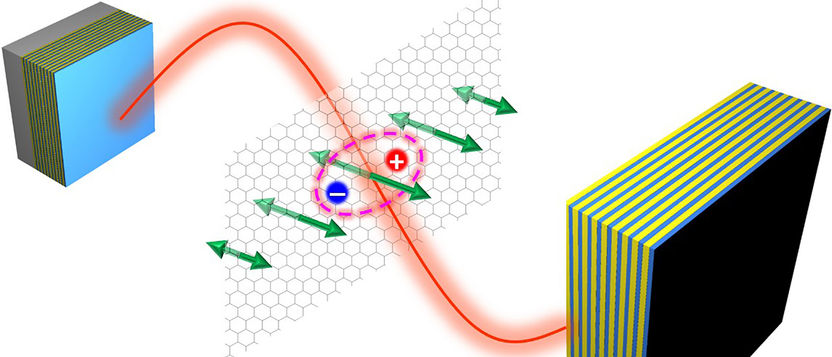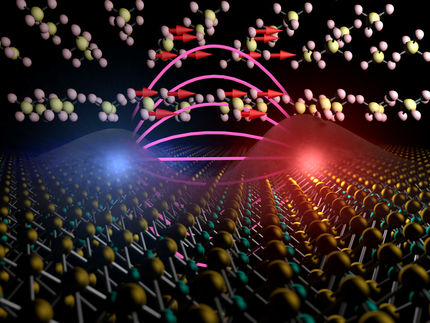Revealing New States in 2D Materials
Researchers have highlighted and quantified a three-fold coupling between exciton, photon, and phonon in a microcavity with embedded two-dimensional materials
Atomically thin two-dimensional (2D) materials can provide highly interesting excitonic properties, which render them an attractive platform to explore polaritonic physics.

Coupling of phonon (green), exciton (pink), and photon of a microcavity (red) in a 2D material.
Donghai Li, Universität Würzburg
In the literature, a variety of inorganic exciton-polariton systems have been studied experimentally and described theoretically using the broadly accepted model of two coupled oscillators, where only the coupling between excitons and cavity photons is considered.
Now, Donghai Li and a group of researchers from Julius-Maximilians-Universität (JMU) Würzburg in Bavaria, Germany, have found that placing 2D semiconductors in microcavities can lead to a strong interaction between not just excitons and cavity photons but also with phonons. The team believes that their results could shift the paradigm of exciton-polariton physics in 2D materials by highlighting and quantifying the role of phonons therein.
Novel method with temporal resolution of 20 femtoseconds
The team developed a novel method of coherent 2D micro-spectroscopy, which provides spectral resolution for both the excitation and detection steps in combination with microscopic spatial resolution and 20 femtosecond temporal resolution.
With this technique, a rich multipeak spectrum of excitations, which thus far remained inaccessible to linear photoluminescence experiments, is mapped.
Comparison with a novel vibronic polariton model, which takes into account not only the degree of freedom of excitons and photons, but also that of phonons reveals multiple polariton branches induced by exciton-photon-phonon hybridization.
This marks the discovery of previously unobserved bright states in microcavities with embedded 2D materials. The JMU researchers expect that the discovery will be of importance for the ongoing attempts of realizing room-temperature Bose-Einstein condensation and polariton lasing in these systems.
Original publication
Other news from the department science

Get the chemical industry in your inbox
By submitting this form you agree that LUMITOS AG will send you the newsletter(s) selected above by email. Your data will not be passed on to third parties. Your data will be stored and processed in accordance with our data protection regulations. LUMITOS may contact you by email for the purpose of advertising or market and opinion surveys. You can revoke your consent at any time without giving reasons to LUMITOS AG, Ernst-Augustin-Str. 2, 12489 Berlin, Germany or by e-mail at revoke@lumitos.com with effect for the future. In addition, each email contains a link to unsubscribe from the corresponding newsletter.



























































